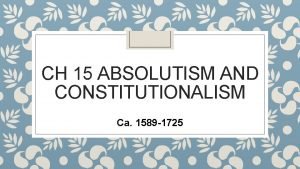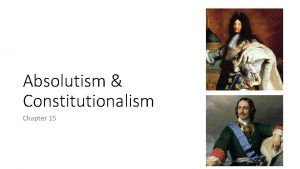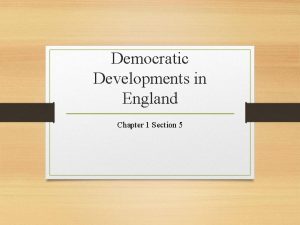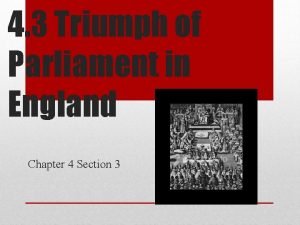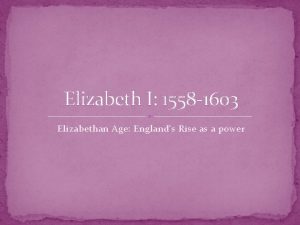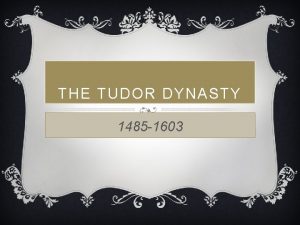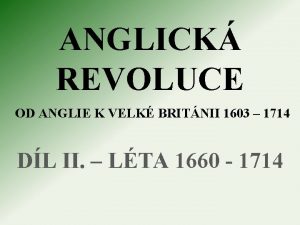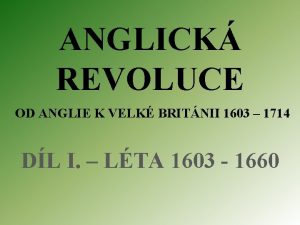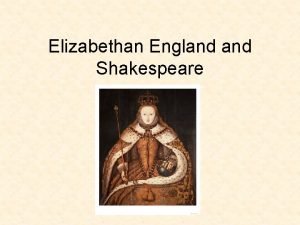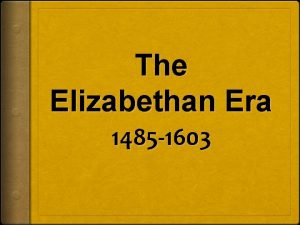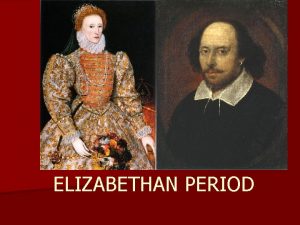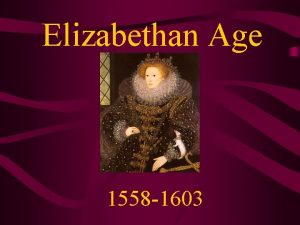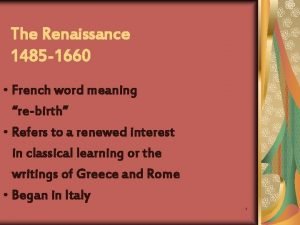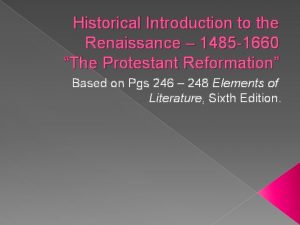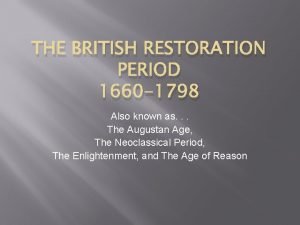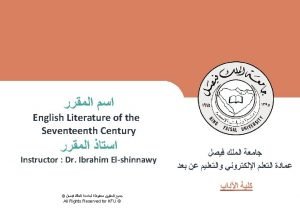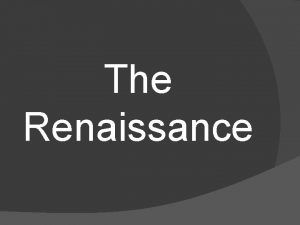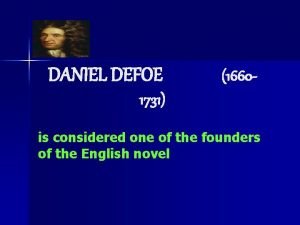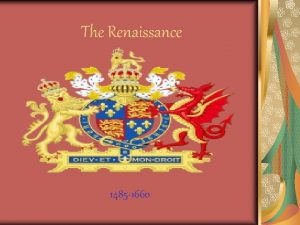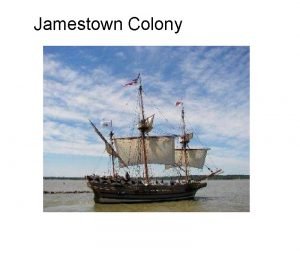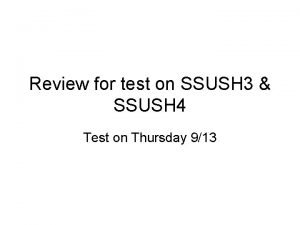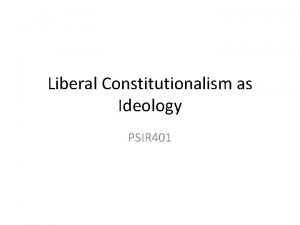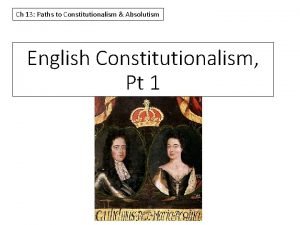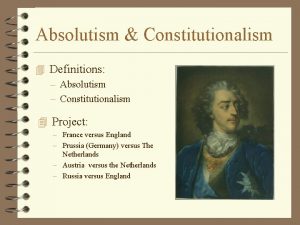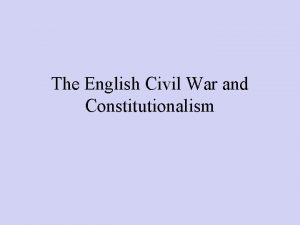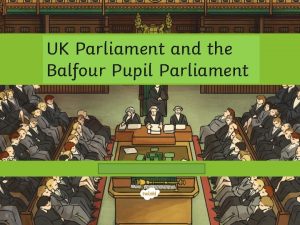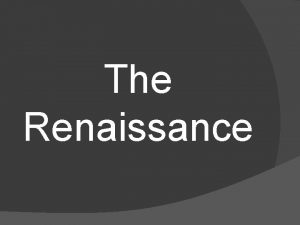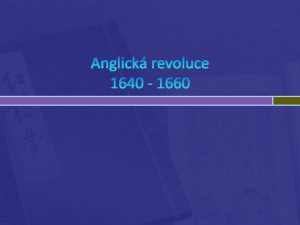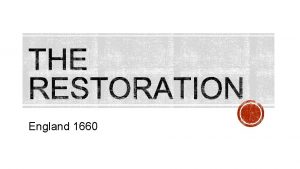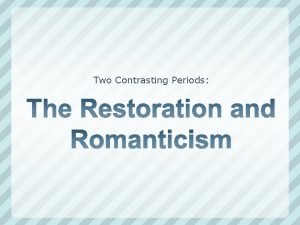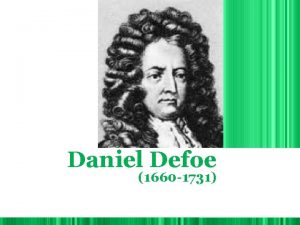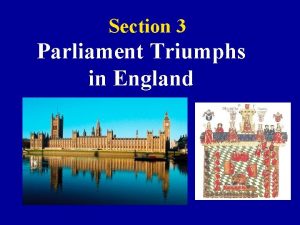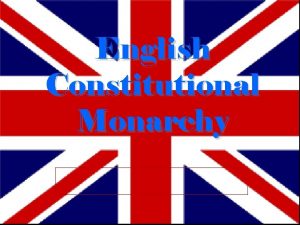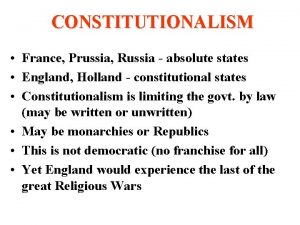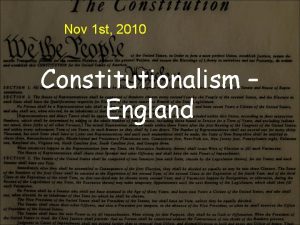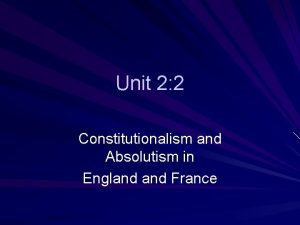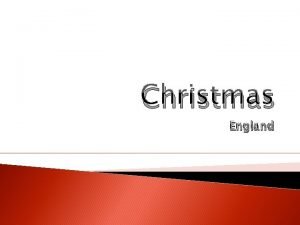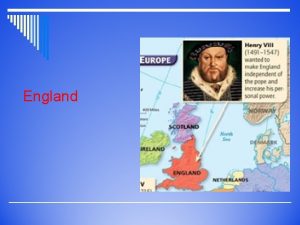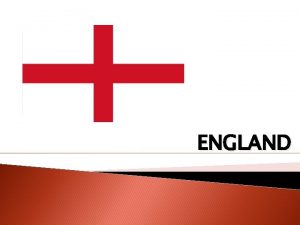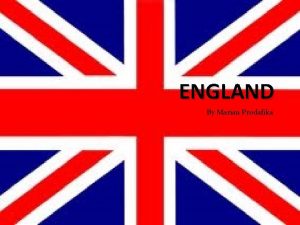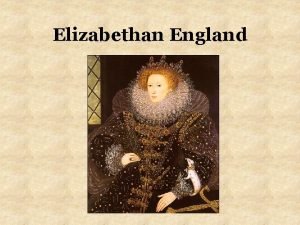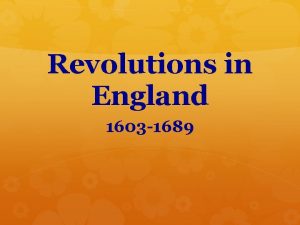England Parliament vs The King 1603 1660 Constitutionalism













![Ship Money Assessments, 1636 [per square mile] a A medieval tax for coastal cities Ship Money Assessments, 1636 [per square mile] a A medieval tax for coastal cities](https://slidetodoc.com/presentation_image_h2/bcfc44b5253d7cfd9958e466d728f244/image-14.jpg)












![% Of Land Owned by Catholics in Ireland [in green] % Of Land Owned by Catholics in Ireland [in green]](https://slidetodoc.com/presentation_image_h2/bcfc44b5253d7cfd9958e466d728f244/image-27.jpg)

- Slides: 28

England: Parliament vs. The King 1603 - 1660

Constitutionalism in Western Europe: c. 1600 -1725 Constitutionalism: Government power is limited by law. There is a delicate balance between the power of government and the rights and liberties of individuals.

English society in the 17 th century • “Capitalism” played a major role in the high degree of social mobility (higher than in the rest of Europe) • Gentry: Wealthy landowners in the countryside who dominated politics in the House of Commons (England’s lower house in Parliament) Were willing to pay taxes so long as the House of Commons had a say in national expenditures » Unlike France, there was no stigma to paying taxes in England. Since the tax burden was more equitable in England, the peasantry was not as heavily exploited. » The issue of taxation brought the House of Commons and the monarchy into direct conflict

Religion • Calvinists comprised perhaps the largest percentage of the population by the early 17 th century while the Anglican Church lost ground • Puritans (the most reform-minded of the Calvinists) sought to “purify” the Church of England by removing many of its Catholic elements • The “Protestant work ethic” profoundly impacted members of the middle-class and gentry. • Calvinists in particular were highly opposed to any influence by the Catholic Church (while James I and Charles I seemed to be sympathetic to Catholicism)

English Monarchy – 17 th Century The Stuarts ruled England for most of the 17 th century Although they exhibited absolutist tendencies, they were restrained by the growth of Parliament. They lacked the political astuteness of Elizabeth I. • James I (1603 -1625): first of the Stuart kings— struggled with Parliament • Charles I (1625 -1629): twice suspended Parliament; beheaded during the English Civil War • Charles II (1660 -1685): restored to the throne but with the consent of Parliament • James II (1685 -1688): exiled to France during the “Glorious Revolution”

Two major issues prior to the Civil War Could the king govern Would the form of the without the consent of Anglican Church follow Parliament or go against the established the wishes of hierarchical Episcopal Parliament? form or acquire a Presbyterian form?

English Monarchy 1603 -1689 1649 -1660 No King – only time in British history James I (16031625) Charles I: 1625 -1649 (beheaded)

The Glorious Revolution: William & Mary proclaimed monarchs by Parliament The Restoration: Charles II 1660 -1685 James II 1685 -1688

James I (r. 1603 -1625) Background –Elizabeth I left no heir to the throne when she died in 1603 –James VI of Scotland was next in line to assume throne; thus England got a Scottish king

• James believed in “divine right” of kings • Firm believer in absolutism (such as that seen by his contemporaries in France, Henry IV and later, Louis XIII) • Twice dissolved Parliament over issues of taxation and parliamentary demands for free speech. – Elizabeth I left behind a large debt – A series of wars (including the 30 Years’ War) were costly and required large gov’t revenues – James unwisely flaunted his wealth (not to mention his male lovers, esp. the Duke of Buckingham)) and thus damaged the prestige of the monarchy.

Charles I (r. 1625 -1649) • Son of James I • Like James, he claimed “divine right” theory of absolute authority for himself as king and sought to rule without Parliament • Also sought to control the Church of England. Tax issues pitted Charles I against Parliament • Charles needed money to fight wars • To save money, soldiers were quartered in English homes during wartime (this was very unpopular) • Some English nobles were arrested for refusing to lend money to the government • By 1628, both houses of Parliament were firmly opposed to the king

Petition of Right (1628) Parliament attempted to encourage the king to grant basic legal rights in return for granting tax increases • Only Parliament had right to levy taxes, gifts, loans, or contributions. • No one should be imprisoned or detained without due process of law. • All had right to habeas corpus (trial) • No forced quartering of soldiers in homes of private citizens. • Martial law could not be declared in peacetime

Charles dissolved Parliament in 1629 • Charles’ ruled without Parliament between 1629 and 1640” – In effect, Charles ruled as an absolute monarch during these 11 years – He raised money using Medieval forms of forced taxation (those with a certain amount of wealth were obligated to pay) – “Ship money”: all counties now required to pay to outfit ships where before only coastal communities had paid. • Religious persecution of Puritans became the biggest reason for the English Civil War
![Ship Money Assessments 1636 per square mile a A medieval tax for coastal cities Ship Money Assessments, 1636 [per square mile] a A medieval tax for coastal cities](https://slidetodoc.com/presentation_image_h2/bcfc44b5253d7cfd9958e466d728f244/image-14.jpg)
Ship Money Assessments, 1636 [per square mile] a A medieval tax for coastal cities for defense. a Charles applied them to inland counties as well. a This got him around the need to call Parliament into session. www. historyteacher. net

The “Short Parliament”, 1640 Charles disbanded Parliament after only a month – Charles I needed new taxes to fight the war against Scotland – Parliament was re-convened in 1640 but refused to grant Charles his new taxes if he did not accept the rights outlined in the Petition of Right and grant church reforms

“Long Parliament” (1640 -1648) – Desperate for money after the Scottish invasion of northern England in 1640, Charles finally agreed to certain demands by Parliament could not be dissolved without its own consent Parliament had to meet a minimum of once every three years “Ship money” was abolished The leaders of the persecution of Puritans were to be tried and executed (including Archbishop Laud) • The Star Chamber (still used to suppress nobles) was abolished • Common law courts were supreme to the king’s courts. • Refused funds to raise an army to defeat the Irish revolt • • – The Puritans came to represent the majority in Parliament against the king’s Anglican supporters Charles enters the House of Commons to end the session and arrest 5 MPs unsuccessful

The Civil War (1642 -1649)

Civil War (1642 -1649) Royalists (Cavaliers) Parliamentarians (Roundheads) a House of Lords † House of Commons a N & W England † S & E England a Aristocracy † Puritans a Large landowners † Merchants a Church officials † Townspeople a More rural † More urban

The English Civil War: 1642 -1645

Cromwell Oliver Cromwell, a fiercely Puritan Independent and military leader of the Roundheads, eventually led his New Model Army to victory in 1649 • Battle of Nasby was the final major battle. • Charles surrendered himself to the Scots in 1646 • A division between Puritans and Presbyterians (and non-Puritans) developed late in the war. • Parliament ordered the army to disband; Cromwell refused. • Cromwell successfully thwarted a Scottish invasion (Charles I had promised Scotland a Presbyterian system if they would help defeat Cromwell

• Pride’s Purge (1648): Elements of the New Model Army (without Cromwell’s knowledge) removed all non-Puritans and Presbyterians from Parliament leaving a • “Rump Parliament” with only 1/5 of members remaining.

Regicide Beheading of Charles I, 1649 • Charles I was beheaded in 1649 • The vote by the Rump Parliament was 68 -67 • This effectively ended the civil war • First king in European history to be executed by his own subjects

New Sects emerge: more radical Levellers: Radical religious revolutionaries; sought social & political reforms—a more egalitarian society † The Agreement of the People was their political manifesto. § Abolish corruption within the Parliament & judicial process. § Toleration of religious differences. § Laws written in the vernacular. § Universal suffrage as a “natural right. ” Diggers: denied Parliament’s authority and rejected private ownership of land † Agrarian “communists” † With Charles I gone, they felt that land should now be distributed to the poor. † Food prices had reached record highs in the 1640 s.

The Interregnum: 1649 -1660 rule without king • The Commonwealth (1649 -1653): a republic that abolished the monarchy and the House of Lords • a. In reality, became a military state with an army of 44, 000 (the best in Europe) • b. Scottish Presbyterians, who opposed Puritan rule, proclaimed Charles II as the new king and Cromwell once again defeated a Scottish invasion

The Protectorate (1653 -1659), Oliver Cromwell Lord Protector (in effect, a dictatorship) • Dissolved the “Rump Parliament” in 1653 after a series of disputes • England divided into 12 districts, each under the control of a military general • Denied religious freedom to Anglicans and Catholics • Allowed Jews to return to England in 1655 (Jews had not been allowed since 1290)

Cromwell’s military campaigns • 1649, Cromwell invaded Ireland to put down an Irish uprising. • Act of Settlement (1652): The land from 2/3 of Catholic property owners was given to Protestant English colonists. • Crushes a rebellion among the Catholics of Ireland kills 40% of all ethnic Irish! • Cromwell conquered Scotland in 1651 -52
![Of Land Owned by Catholics in Ireland in green % Of Land Owned by Catholics in Ireland [in green]](https://slidetodoc.com/presentation_image_h2/bcfc44b5253d7cfd9958e466d728f244/image-27.jpg)
% Of Land Owned by Catholics in Ireland [in green]

Life Under Cromwell • The Puritan-controlled gov’t sought to regulate the moral life of England by commanding that people follow strict moral codes that were enforced by the army. • The press was heavily censored, sports were prohibited, theaters were closed • This seriously alienated many English people from Cromwell’s military rule • Cromwell died in 1658 and his son, Richard, was ineffective as his successor. – The Stuarts under Charles II were restored to the throne in 1660.
 Chapter 15 absolutism and constitutionalism
Chapter 15 absolutism and constitutionalism Chapter 15 absolutism and constitutionalism
Chapter 15 absolutism and constitutionalism Democratic developments in england
Democratic developments in england Lesson 3 triumph of parliament in england
Lesson 3 triumph of parliament in england 1603 anglie
1603 anglie Kaspersky 1603
Kaspersky 1603 1485 to 1603
1485 to 1603 Velk�� brit��nie pr��ce
Velk�� brit��nie pr��ce 1603 anglie
1603 anglie Caernorfon
Caernorfon What happened in 1603 shakespeare
What happened in 1603 shakespeare Apothecary elizabethan era
Apothecary elizabethan era Elizabethan era context
Elizabethan era context 1603 in inglese
1603 in inglese Error 1603 kaspersky
Error 1603 kaspersky 1558 1603
1558 1603 Daniel defoe was born in 1660 into a family of dissenters
Daniel defoe was born in 1660 into a family of dissenters Renaissance is a french word that means
Renaissance is a french word that means Renaissance (1537 ad - 1660 ad)
Renaissance (1537 ad - 1660 ad) The restoration period
The restoration period The english renaissance 1485 to 1660
The english renaissance 1485 to 1660 Comment on paradise lost as a puritan age document
Comment on paradise lost as a puritan age document Mikroskop 1660
Mikroskop 1660 Renaissance (1537 ad - 1660 ad)
Renaissance (1537 ad - 1660 ad) Robinson crusoe analysis
Robinson crusoe analysis Mikroskop 1660
Mikroskop 1660 The renaissance 1485 to 1660 unit introduction
The renaissance 1485 to 1660 unit introduction Jamestown colony
Jamestown colony Ssush
Ssush
